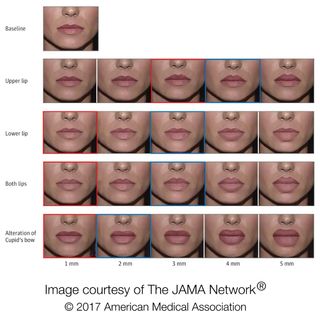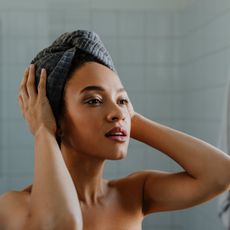
In 2017, lips are far beyond just a body part we use to talk, eat, and drink.
Thanks in no small part to Kylie Jenner's plumped-up fish gape, they're a full-on obsession in the cultural zeitgeist. And because of the major surge in filler injections, like Botox and Juvaderm, when we come across a full pout these days—be it IRL or on the cover of a magazine in the grocery checkout line—it begs the did-she-or-didn't-she? question like never before.
Honing in on this phenomenon is a newly-released study conducted by JAMA Facial Plastic Surgery, which seeks to indentify what characteristics of cosmetically-enhanced lips veer into artificial-looking territory. The research was conducted by two plastic surgeons, Dr. Sang W. Kim and Dr. Daniel E. Rousso, who were looking to gain a better understand of how much is too much?
"One of the main challenges for clinicians is to know when to stop treating the lips before the results appear artificial and unnatural," they state in the study. "Despite the best intentions, this decision can sometimes lead to misguided and unintended consequences."

The doctors asked 98 volunteers (76 women and 22 men) to view digitally-morphed photos of a 35-year-old woman's lips in which the upper lip, lower lip, both lips, and the cupid's bow were manipulated at increments between 1 mm and 5 mm. The photos were uploaded to an online questionnaire and participants rated each photo in random order according to whether or not they thought they were attractive and if they thought they looked natural or unnatural.
The Lip Injection Giveaways
If you're looking to firmly decipher whether or not someone has had injections, be forewarned: A major takeaway for the surgeons was that a quantitative measurement of the lips as a fixed guideline for augmentation isn't exactly realistic—there are just too many individual variables.
However, there are some key takeaways from the results that could hint at artificial alteration to the lip area if you're looking out for it.
Stay In The Know
Marie Claire email subscribers get intel on fashion and beauty trends, hot-off-the-press celebrity news, and more. Sign up here.
1. The *ratio* between the upper and lower lips. There are exceptions of course, but people appear to believe that the lower lip should be larger (about 1.6 times) the height of the upper lip. Furthermore, injecting just the upper lip, as opposed to both the upper and lower lips, has a narrower margin for error in terms of artificial appearance.

2. Alterations to the Cupid's bow are risky. The study found that any alternation to the Cupid's bow resulted in the narrowest margin for artificial appearance. So basically, if the natural double-arch shape has been comprised by too much filler, the human eye really picks up on it.
We're nominated for a Webby Award—but we need your vote to win! Vote for the Women and Guns project here.

Lauren is the former beauty editor at Marie Claire. She love to while away the hours at coffee shops, hunt for vintage clothes, and bask in the rough-and-tumble beauty of NYC. She firmly believes that solitude can be a luxury if you’ve got the right soundtrack—that being the Rolling Stones, of course.
-
 Sophia Bush Publicly Comes Out as Queer For the First Time in Moving Personal Essay
Sophia Bush Publicly Comes Out as Queer For the First Time in Moving Personal Essay“I finally feel like I can breathe.”
By Danielle Campoamor Published
-
 Bella Hadid Teases Her New Brand in Three Nearly-Naked Outfits
Bella Hadid Teases Her New Brand in Three Nearly-Naked OutfitsThe supermodel gave fans a sneak-peek at her upcoming label.
By India Roby Published
-
 Céline Dion Says Her Epic Wedding Tiara Put Her in the Hospital
Céline Dion Says Her Epic Wedding Tiara Put Her in the Hospital"The pressure was too much."
By Danielle Campoamor Published
-
 The 32 Best Hair Growth Shampoos of 2024, According to Experts
The 32 Best Hair Growth Shampoos of 2024, According to ExpertsRapunzel hair, coming right up.
By Gabrielle Ulubay Published
-
 The 20 Best Hair Masks for Damaged Hair, According to Experts and Editors
The 20 Best Hair Masks for Damaged Hair, According to Experts and EditorsHealthy strands, here we come!
By Gabrielle Ulubay Last updated
-
 How Often You Should Wash Your Hair, According To Experts
How Often You Should Wash Your Hair, According To ExpertsKeep it fresh, my friends.
By Gabrielle Ulubay Published
-
 The 11 Best Magnetic Lashes of 2023
The 11 Best Magnetic Lashes of 2023Go ahead and kiss your messy lash glue goodbye.
By Hana Hong Published
-
 Beauty Advent Calendars Make the Perfect Holiday Gift
Beauty Advent Calendars Make the Perfect Holiday GiftThe gift that keeps on giving.
By Julia Marzovilla Last updated
-
 The 18 Best Natural Hair Products in 2023
The 18 Best Natural Hair Products in 2023Remember: Your curls are your crown.
By Gabrielle Ulubay Published
-
 The 9 Best Hot Rollers for the Curls of Your Dreams
The 9 Best Hot Rollers for the Curls of Your DreamsThis is how we roll.
By Samantha Holender Published
-
 The 12 Best Cream Eyeshadows, According to Makeup Artists
The 12 Best Cream Eyeshadows, According to Makeup ArtistsThe best part? They’re so easy to apply.
By Samantha Holender Published